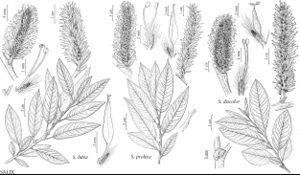Difference between revisions of "Salix humilis"
Arbust. Amer., 140. 1785.
FNA>Volume Importer |
FNA>Volume Importer |
(No difference)
| |
Revision as of 22:52, 16 December 2019
Shrubs, 0.3–3 m, (forming clones by layering). Stems: branches dark red-brown, not or weakly glaucous, tomentose to glabrescent; branchlets red-brown, yellow-brown, or greenish brown, moderately to very densely villous, tomentose, or velvety-tomentose to glabrescent. Leaves: stipules absent or rudimentary on early ones, absent, rudimentary or foliaceous on late ones, apex acute; petiole convex to flat, or shallowly grooved adaxially, 0.5–7(–12) mm, velvety, pilose, or villous adaxially; largest medial blade (sometimes hemiamphistomatous), narrowly oblong, narrowly elliptic, elliptic, oblanceolate, obovate, or broadly obovate, (13–)20–90(–135) × 3–23(–35) mm, 2.3–9 times as long as wide, base cuneate or convex, margins revolute or flat, entire, crenate, or sinuate, (glands submarginal), apex acuminate or convex, abaxial surface glaucous, sparsely to densely tomentose or woolly, hairs erect or spreading, wavy, adaxial slightly or highly glossy, glabrous, pubescent, tomentose, or pilose; proximal blade margins entire or serrulate; juvenile blade green, densely tomentose to glabrescent abaxially, hairs white, sometimes also ferruginous. Catkins flowering before leaves emerge; staminate 6.5–34 × 5–19 mm, flowering branchlet 0–1 mm; pistillate (and staminate) moderately to very densely flowered, stout, subglobose, or globose, 9–47(–55 in fruit) × 5.5–19 mm, flowering branchlet 0–4 mm; floral bract brown, black, or bicolor, 0.8–2 mm, apex rounded or acute, abaxially moderately densely hairy, hairs (white), straight or wavy. Staminate flowers: adaxial nectary oblong or square, 0.2–0.7 mm; filaments distinct, glabrous or hairy basally; anthers purple turning yellow, ellipsoid or cylindrical, 0.4–0.6 mm. Pistillate flowers: adaxial nectary square, 0.4–0.8 mm, shorter than stipe; stipe 1–2.5 mm; ovary obclavate or pyriform, moderately densely to sparsely short-silky-villous (hairs refractive), beak slightly bulged below styles, (valves recurving in fruit); ovules 6–12 per ovary; styles (sometimes slightly distinct distally), 0.2–0.4 mm; stigmas slenderly to broadly cylindrical, 0.2–0.56 mm. Capsules 5–12 mm.
Distribution

North America.
Discussion
Varieties 2 (2 in the flora).
Varieties humilis and tristis are almost sympatric. In Maine they occur in the same populations without evident intermediate forms, while in other places, e.g., Florida, Georgia, and Nebraska, they apparently intergrade. Usually, they are distinct in habit, leaf and catkin size, and, most conspicuously, the presence of foliaceous stipules in var. humilis and their absence in var. tristis.
Selected References
None.
Lower Taxa
Key
| 1 | Stipules on late leaves foliaceous; largest medial blades (20-)50-90(-135) mm; petioles (1.5-)3-7(-12) mm; staminate catkins 14.5-34 mm; pistillate catkins longer than 20 mm; peeled wood smooth or striate, striae dense, to 20 mm. | Salix humilis var. humilis |
| 1 | Stipules on late leaves absent or rudimentary; largest medial blades (13-)20-50(-70) mm; petioles 0.5-3(-6) mm; staminate catkins 6.5-13.5 mm; pistillate catkins shorter than 20 mm; peeled wood smooth or striate, striae sparse, to 2 mm | Salix humilis var. tristis |
